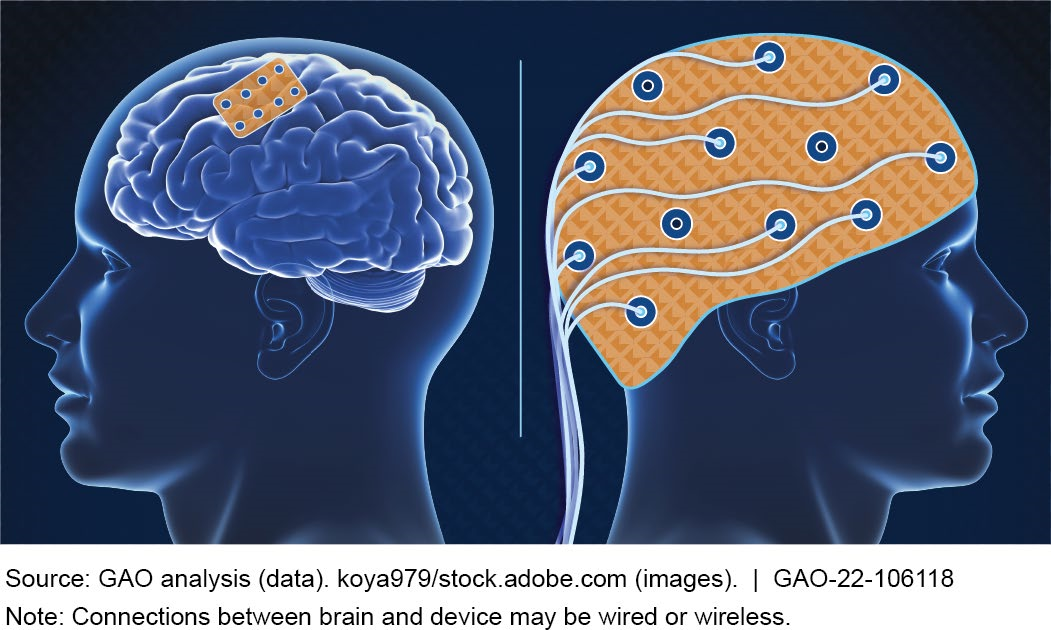Science & Tech Spotlight: Brain-Computer Interfaces
Fast Facts
Brain-computer interfaces allow people to control machines using their thoughts. The technology is still largely experimental, but its possibilities are vast. For example, it could help people with paralysis regain control of their limbs and enable servicemembers to operate a drone hands-free on the battlefield.
Yet, creating a direct connection between brain and machine may raise concerns. For example, it could give users unfair advantages by enhancing physical and cognitive abilities. Also, hackers could steal data related to a person's brain signals.
In this spotlight, we explore these and other policy issues related to this technology.

Highlights
Why This Matters
Brain-computer interfaces allow people to control machines using their thoughts. These interfaces can help people with disabilities as well as enhance human-computer interactions. For example, warfighters might operate a drone hands-free on the battlefield. However, the technology remains largely experimental, and it raises questions about security, ethics, and equity.
The Technology
What is it? A brain-computer interface (BCI) enables a person to control an external device using brain signals. BCIs could aid people with disabilities and improve national defense capabilities, among other uses. For example, researchers are developing BCIs that allow people with paralysis to spell words on a computer screen or regain control of their limbs. In addition, researchers are developing BCI-controlled robotic limbs that can provide users with a sense of touch. BCIs could also augment human capabilities by allowing people to control computerized machinery using their thoughts, for example (see fig. 1).

Figure 1. Examples of BCI applications include a speller for communication, a smartphone interface, a BCI-operated drone, and a robotic limb.
How does it work? New BCI users often undergo an iterative training process. The user learns to produce signals the BCI will recognize, and the BCI translates the signals to operate a device using machine learning.
Generally, BCIs connect to the brain in two ways: through implanted or wearable devices (see fig. 2). Implanted BCIs are often surgically attached directly to brain tissue. They may be more appropriate for users with severe neuromuscular disorders or physical injuries. For example, a person with paralysis could use an implanted BCI that is attached to specific neurons to regain precise control of a limb. Implanted BCIs measure signals directly from the brain, reducing interference from other tissue. However, they pose surgical risks, such as infection and rejection. Some implanted BCIs reduce risk by placing electrodes on the surface of the brain, a method called electrocorticography (ECoG).
Wearable BCIs often require a cap containing conductors that measure brain activity detectable on the scalp. A wearable BCI may be appropriate for purposes like augmented and virtual reality, gaming, or controlling an industrial robot. Most wearable BCIs use electroencephalography (EEG) to measure the brain's electrical activity. An emerging method—functional near-infrared spectroscopy (fNIRS)—shines near-infrared light through the skull to measure blood flow, which can indicate information such as the user's intentions.
To enhance mobility, researchers are developing BCIs that use portable methods to acquire data—for example, wireless EEG. These methods allow users to operate a smartphone or other device while moving freely.

Figure 2. Examples of implanted (left) and wearable (right) BCIs.
How mature is it? Most BCIs are experimental. Researchers first tested a wearable BCI in the early 1970s and implanted a BCI in a human for the first time in the late 1990s. BCI research has increased significantly in the 21st century resulting in the publication of thousands of research papers. According to one leading BCI company, fewer than 40 people worldwide have implanted BCIs, all of them experimental. One of the main obstacles to BCI development is that each person generates unique brain signals. Another is the difficulty of measuring those signals.
Historically, BCI research has focused on biomedical applications, such as helping people disabled by a stroke, physical injury, or neurological disorder. In April 2021, a device that uses a wireless EEG headset to help stroke patients regain arm and hand control became the first wearable BCI for rehabilitation to receive market authorization from the Food and Drug Administration. A number of other wearable and implanted BCIs for medical uses are currently in clinical trials.
Researchers are also developing applications for military use and for systems whose proper operation is critical to safety. For example, researchers at the National Aeronautics and Space Administration have used BCIs to help detect when pilots and air traffic controllers are more likely to make mistakes. The Department of Defense has funded research on BCIs for hands-free control of drones. And the Federal Aviation Administration has looked into how to medically certify pilots who may one day use BCIs to control airplanes.
What are some concerns? Some researchers have noted possible legal and security implications of BCIs. For example, cyberattacks are a concern because hackers could use malware to intercept brain signal data stored on a smartphone. The Department of Commerce is currently reviewing whether exporting BCIs could pose national security concerns. For example, foreign adversaries could obtain a military or intelligence advantage. Its decision could affect how the technology is used and shared overseas.
Researchers have also pondered societal and ethical implications. Reported costs of wearable BCIs range from hundreds to thousands of dollars, which may result in unequal access. Additionally, learning to use some types of BCIs requires training, which may burden users. Researchers have also suggested that translation of brain signals to speech by a BCI could cause harm if it is not accurate. For example, inaccurate translation might indicate legal or medical consent that the person did not intend to give.
Opportunities
- Help people with disabilities. People paralyzed by physical injuries or neurological disorders could use BCIs to communicate and regain control of their limbs.
- Augment human capabilities and human-computer interactions. BCIs could accelerate and simplify interactions between humans and machines in fields like defense and space. Also, some researchers have suggested that BCI-controlled robots could assist people in hazardous environments, such as coal mines.
- Facilitate brain research. Scientists could use BCIs to improve understanding of the brain. Some researchers have used a BCI to detect the emotions of patients in a vegetative or minimally conscious state.
Challenges
- Technical and user challenges. Each person generates unique brain signals, which are difficult to measure clearly. Also, learning to use a BCI can require substantial training.
- Ethical framework. BCIs may raise questions about what constitutes consent and about potential unfair advantages conferred by certain human enhancements.
- Security and privacy. BCIs could be vulnerable to cyberattacks that expose brain data or interfere with a device’s function.
Policy Context and Questions
- As BCIs develop toward commercial and patient use, will they be accessible to all, and who will bear the cost?
- How should BCIs that augment human capabilities be regulated, if at all?
- What ethical issues might BCIs raise, and what applications might constitute unethical or controversial use of BCIs?
- What steps might help to mitigate potential security and privacy risks associated with the acquisition of brain signal data?
For more information, contact Karen Howard at (202) 512-6888 or HowardK@gao.gov.
